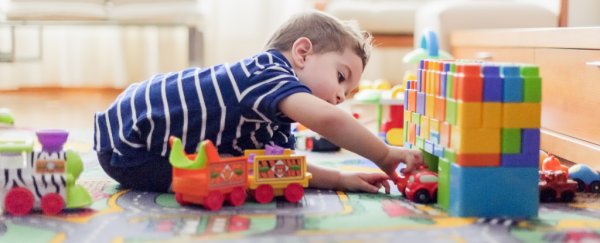The potential health risks of chemicals used in plastic toys have had scientists concerned for years, but new research reveals just how widespread the risk of harm to children remains.
In an international study, researchers assessed the chemical compositions of toys and estimated levels of human exposure to the substances, ultimately finding over 100 "Chemicals of Concern" in plastic toy materials that could pose a non-negligible health risk to children.
"Out of 419 chemicals found in hard, soft, and foam plastic materials used in children toys, we identified 126 substances that can potentially harm children's health either via cancer or non-cancer effects, including 31 plasticisers, 18 flame retardants, and 8 fragrances," explains quantitative sustainability researcher Peter Fantke from the Technical University of Denmark (DTU).
According to the researchers, while laws in many countries regulate the use of certain potentially toxic chemicals in plastic toys, there is no consistent approach internationally, and current protections don't adequately prohibit the vast extent of potentially harmful substances that toys are made from.
"Existing regulations usually focus on particular chemicals (e.g. phthalates, brominated flame retardants, and metals), while currently not covering the broad range of chemical substances that are found in plastic toys," the team, led by first author and PhD student Nicolò Aurisano, writes in the study.
"In addition, some toxic and banned additives are still found in plastic toys also on regulated markets, for example in case of recycling contaminated plastics, unawareness by producers, or absence of regulations in the producing country."
To highlight the scale of the problem, the researchers compiled a list of the chemical contents of toy material – something that isn't readily disclosed by product manufacturers, but which has nonetheless been analyzed in previous investigations by scientists.
Bringing together chemical data from 25 peer-reviewed studies – and assessing risk of substance exposure based on how particular toys are handled – Fantke's team constructed their list of chemicals of concern, ranked in terms of risk prioritization.
"We have combined the reported chemical content in toy materials with material characteristics and toy use patterns, such as how long a child typically plays with a toy, whether it puts it into the mouth, and how many toys are found in a household per child," Aurisano says.
"We used this information to estimate exposure using high-throughput mass-balance models, and compared exposure doses with doses below which there is no unacceptable risk to the children."
Of the 126 chemicals of concern identified in the study, 27 substances – including numerous phthalates, flame retardants, and plasticizers – are already commonly regulated (but still turned up in the toys tested).
But the researchers also identified 17 substances they define as chemicals of concern that do not appear in other priority lists for plastic toys, but which nonetheless could be hazardous to health.
Some of these substances are known as 'regrettable substitutions': chemicals that start to be used as alternatives to known harmful chemicals, but which turn out to be hazardous themselves.
Other chemicals of concern identified in the study included substances that may be harmful, but which appeared within acceptable levels, or which could not be quantified in terms of risk exposure for various reasons.
Moving forward, the researchers say a set of thresholds called the 'maximum acceptable chemical content' could be used to establish limits on the amounts of chemicals of concern inside toys, bridging the gaps between the different regulatory systems that exist today.
"Since the same chemicals can be found in different concentrations across toy materials, we have estimated the 'maximum acceptable chemical content' for all the substances reported to be found in plastic toys," Fantke says.
"Such information will enable decision-makers to develop benchmarks for various chemicals in different applications, but will also help toy companies to evaluate the amount of chemicals used for a specific function against such benchmarks."
Until those kinds of decision-makers get a grip on this kind of stuff, though, the most proximate decision-makers in this context – parents – can still act on the results reported here.
The most simple thing to do: stop surrounding children with plastic toys.
According to the researchers, children in western countries accumulate on average 18.3 kilograms (40 lbs) of plastic toy materials each year – and we're only just beginning to figure out what all that mass really contains.
"An efficient and practical way to reduce exposure to priority chemicals present in plastic toys is to reduce the amount of new toys introduced into our households every year," the researchers write.
"This is also supported by a recent study showing that the quality of children play is negatively influenced by the abundance of toys, and that fewer toys may help toddlers to focus better and play more creatively."
The findings are reported in Environment International.
